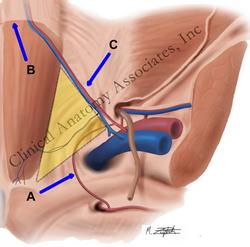
Hesselbach's triangle.
Click for a larger image.
UPDATED: From the Greek [ep(i)] meaning "outer, above, or upon", and the Greek suffix [o-nym] meaning "name". The word [eponym] refers to a person's name becoming attached to an anatomical location or surgical procedure. For centuries it has been the custom to honor or remember someone by attaching their name to a structure, location, procedure, or maneuver.
This has changed as anatomists tend now to give locations and structures descriptive terms. An example of this would be the "Ampulla of Vater" named after the German anatomist Abraham Vater (1684-1751) described today in anatomical texts as the "hepatopancreatic ampulla". The controversy on using eponyms or not goes on...
There are many eponymical terms in the medical arena; following are some of them, click on the links for additional information:
• Hesselbach’s triangle: Named after Franz Kaspar Hesselbach (1759-1816) (see yellow insert in superior image)
• Spigelian line (linea semilunaris): Site for an Spigelian hernia, named after Adrian Van Der Spigelius (1578-1625) (see blue arrow in inferior image)
• Fallopian tube: Named after Gabrielle Fallopius (1523-1563)
• Cooper's pectineal ligament. Named after Sir Astley Paston Cooper (1768-1841)
• Hartmann's procedure: A two-stage colon resection and anastomosis. Named after Prof. Henri Hartmann (1860-1952), a French surgeon.
• Heimlich's maneuver: Named after Dr. Henry J. Heimlich (1920 - 2016)
• Ligament of Treitz: Named after Václav Treitz (1819 - 1872), a Czech pathologist.
• Sphincter of Oddi. Named after Ruggero Oddi (1864 - 1913), an Italian anatomist.
If you want to see a listing of the eponyms in this website, click here.
Here is an article on "The lost influence of Andreas Vesalius on eponymic anatomy".
Here is an interesting article on eponyms by Ilana Yurkiewicz published on 11/15/2012 in Scientific American: "Modern medical terms are still named after Nazi doctors. Can we change it?". It is interesting and thougthful reading.
PERSONAL NOTE: Many anatomists today are actively trying to eliminate eponyms from anatomical, medical, and surgical books. For me, this eliminates the interest of learning about the people who either first described these structures or procedures, which is one of the objectives of this website. I wonder (and this is a tongue-in-cheek comment) if the reason for this desire to eliminate eponyms is because there are so many attached to anatomical structures that there is no place for their own names! When history has forgotten about the original eponyms maybe we will see new ones with the names of modern anatomists! I do not worry, my name is attached to the "Ligaments of Miranda"... don't ask! Dr. Miranda
Superior image property of: CAA.Inc.. Artist: M. Zuptich.
Inferior image property of :CAA.Inc.. Artist:D.M. Klein



